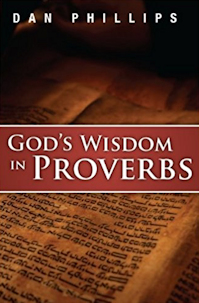Structure. Scary. Though I've read and loved Proverbs since before many of you were born, the shape of chapters 1—9 remained a thing of mystery and terror to me. That may be an exaggeration, but it isn't much of a one.
Obviously, I could tell (and wrote about the fact!) that those chapters stood off from the rest of the book. They were longer, they were discourses of multiple verses, whereas "Proverbs of Solomon" at 10:1a signals the beginning of largely one-verse proverbs of two lines each. That much was plain.
Ah, but how many discourses? Where did they actually start and stop? Could you tell? Was there any progression from one to the other, or was it just a series of random sections? I mean, just look at 1:8ff. That's pretty clearly its own section... and then v. 20 signals a change. And then most of the chapters have discourses of at least some length to them.
But then you get to chapter 6. Just look at it.
Proverbs 6: Rollicking randomness? Starts off talking to "My son" (v. 1), so that's promising. And it's about going surety, whatever that is. It goes along and then... whoops! Now we're suddenly talking to the sluggard (v. 6). No transition, just five short verses then bam! And along we go ragging on the sluggard, and then whoops! again, we're musing aloud about a worthless person (v. 12), which we do for awhile until whoops! now we're listing off
So what's that all about? Is it just five unconnected sections? Fewer, more? See, you have to decide this before you teach or preach it, or you just can't, you don't know how — because you haven't seen what Solomon was doing. If you don't see what Solomon was doing, you don't see what God was doing, and you're not ready to preach or teach it.
As an aside, I'd wager this is a reason why more don't preach Proverbs. These aren't easy questions to answer with confidence, and the literature is only sometimes helpful. That is, the academics don't write for preachers, and the preachers (tend to) lack the necessary chops to answer these questions competently.
Getting under the hood. So I dove in hammer and tongs, making my own observations and ransacking others'. As I've taken to doing, I created files just on this issue — the shape of Proverbs 6. My file on that is 19 single-spaced pages in Word, and contains a number of tables and illustrations. It wasn't a cakewalk.
For starters, it was pretty clear that vv. 20-35 hung together as a self-contained, complete discourse. Whew. But what of vv. 1-19? Here were my first impressions.
OK, I liked that I'd come up with five "S" summaries. That was... well... sweet. Any preacher would love that. But were they really completely separate? The commentators — those who even wrestle with shape — were all over the map. How to decide?
Is it getting hotter in here? Well, when you start looking at it more closely, you do start to notice a progression and cohesion in the first 19 verses. How? Well, as I note above, the first section is addressed to "My son," which is close, it is intimate. The second section is also addressed, but this time it is to the "sluggard." That's not so intimate! It isn't as bad as a fool or a scoffer, for whom there is little or no hope respectively. But it's still an address.
And then the third section is addressed to no one. It is a deeper level of condemnation, of contempt. In the first two, Solomon is speaking-to; in this, he is speaking-about. There's a progressive distancing. Now, this is classically Proverbial. Very often Line B is an escalation of Line A. So it doesn't surprise to see an escalation as the sections progress.
 Indeed, on further reflection you see the sense in this. In the first section (vv. 1-5), the son has made a bad decision in one area of his life which will come back to bite him. It may have been good-hearted, meant to help someone else, but still it is risky and foolish. So Solomon urges him to do what he needs to do to get out of it honorably, right away. If it goes wrong, it means financial ruin. Then in the second section (vv. 6-11), it is the sluggard, and he's making bad decisions in many areas of his life. He is thinking of no one else; he's not even thinking of his own future. He's dumber than a bug! One day, he'll find his ability to choose all-gone, as the armed man puts a sword to his chin and takes away all his freedom.
Indeed, on further reflection you see the sense in this. In the first section (vv. 1-5), the son has made a bad decision in one area of his life which will come back to bite him. It may have been good-hearted, meant to help someone else, but still it is risky and foolish. So Solomon urges him to do what he needs to do to get out of it honorably, right away. If it goes wrong, it means financial ruin. Then in the second section (vv. 6-11), it is the sluggard, and he's making bad decisions in many areas of his life. He is thinking of no one else; he's not even thinking of his own future. He's dumber than a bug! One day, he'll find his ability to choose all-gone, as the armed man puts a sword to his chin and takes away all his freedom.So the first is bad, and the second is worse. Will this continue to the third (vv. 12-15)? Indeed it does. Solomon signals this by not even deigning to speak to this man; he speaks only of him. And what a wreck he is: he's wicked and he's worthless. He sins against God in six different ways, involving his mouth, his eyes, his feet, his finger, his heart. Whereas the son who's gone surety may face financial ruin, and the sluggard utter destitution, this man will be irreparably broken and ruined.
So now you're seeing that indeed the sections are related, they do hang together, and in a classically Solomonic way. The first paints a bad portrait, the second worse, and the third is worst of all.
Four? or three? Or is it? Must we confine it to vv. 12-15? Then what of vv. 16-19? That would be awkward: the first fifteen verses hang together, the last sixteen verses hang together, but between them are just four random verses?
So we look closer, and ponder further. We notice that the first section (vv. 1-5) is five verses long, and the second (vv. 6-11) is six verses long. This is a progression. But then, if it stands alone, the third steps back and is only four verses long (vv. 12-15). Moses doesn't have a law against it, but it does seem anticlimactic. So what if we join vv, 16-19 to vv. 12-15? Then the third section becomes eight verses long, which is a fitting climax to the progression.
Yet at first blush, the two sections don't seem to cohere. There's a musing-aloud about the worthless man (vv. 12-15), and then there's a list of
But look again. How many horrid crimes are charged to the worthless man? From my translation:
- Walks with a twisted mouth,
- Winks with his eyes
- Signals with his foot
- Points with his fingers
- With perversities in his heart/Devises evil at all times
- He spreads conflicts.
Seven.
Okay then, that is progression. And there's more. There's a conceptual hinge, right in the middle. The last verse of the first section (v. 15) promises judgment on this man, but does not explicitly say that it is Yahweh who will bring that judgment. Then in a mirror image, the first verse of the next section (v. 16) reveals that Yahweh condemns certain traits — but does not explicitly say that He will bring judgment on these people. That hinge connects the two sections, pairs them.
One other thing. In the first section the "son" is addressed twice. In the second, the "sluggard" is addressed twice. Doesn't it make sense for Solomon to take two passes at describing what Yahweh really finds unbearably noxious, in the climactic section?
Catchy. There are also indicators in Hebrew that show the sections as relating, the use of catchwords (forms of the same word, or synonyms). Steinmann lists them out, as does Waltke. Hoping it's of some use to you, here's a color-coding I did based on my translation, trying to illustrate the catch-words which, you'll notice, run throughout the sections:
If you struck your palm for a stranger,
You have been trapped by the sayings of your mouth.
For you have come into the palm of your neighbor:Go, grovel, and pester your neighbors!
Or slumber to your eyelids;
As a bird from the hand of the fowler.
See her ways, and become wise.
Administrator, or ruler,
Gathers, in the harvest, her food.
When will you rise from your sleep?
A little folding of the hands to lie down….”
And your lack like an armed man!
Is he who walks with a twisted mouth,
Points with his fingers,
Devises evil at all times.
He spreads conflicts.
Instantly he is broken,
And with no healing.
in fact, seven are abominations to His soul.
A deceptive tongue,
And hands shedding innocent blood;
And one spreading conflicts between brothers. [DJP]
Dumb: Financial Folly
Dumber: Squandered Treasures (My dear wife really liked this one. Just sayin')
Dumbest: Antagonizing God
So, what of the final section (vv. 20-35)? Does it relate? Should we do as Ortlund does, lump it with chapter 7 as being about immorality?
Next time, DV.
This way to the fifth and final post
Previously:
First post: Introduction and Overview:
Second post: Getting Started
Third post: Commentaries














6 comments:
I'm no preacher, but I'm finding your analysis of this section of Proverbs instructive and engaging. Thank you, Pastor.
Thanks for saying so, Grant.
I know this series is not generating a lot of comment traffic, but it has definitely been enjoyable to read. It is helpful to see how others dive into complex texts. Thanks!
Thanks, Dale. If the series came to the notice of other high-traffic sites that normally do recommend series on (A) preaching and (B) Proverbs (let alone both!), we might have more company. Professor David Murray did commend the series at its start; perhaps others are waiting for it to be finished before sharing it with their readers. If so, that's just a post or two away.
Honestly, I have never seen the inner workings of how a sermon like this comes about. It seemed always so simple, but now I am thinking differently. Thank you for that!
Great examples of careful observation of the text, Dan. Thanks for walking us through it and showing us how to sit under the sacred Scripture!
Post a Comment